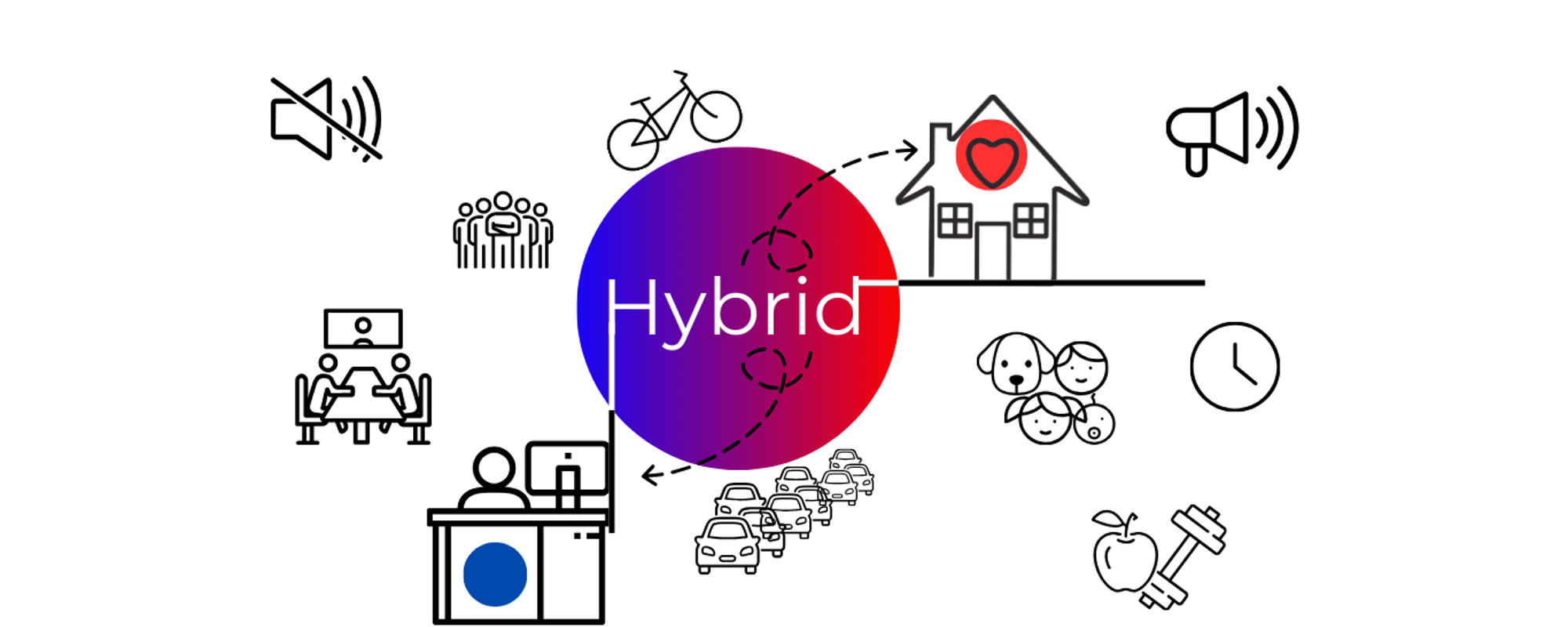How does hybrid working affect organisational culture?
Cultural Shifts: The Hybrid Work Ripple Effect
The transition to hybrid working isn't just a logistical change; it's a cultural metamorphosis. Here's how this new work model is reshaping the organisational culture:
Blurring the Lines Between Personal and Professional: As per Santillan et al. (2023), hybrid working has redefined the boundaries between work and life, demanding a more flexible and empathetic approach to employee needs.
Redefining Communication and Collaboration: The shift to a mix of remote and in-office work necessitates innovative communication strategies, as highlighted by Vasilieva (2021), to keep the team spirit alive across digital divides.
A New Leadership Playbook: Leaders are now orchestrating teams that are both visible and invisible, requiring a blend of trust and technology to keep the symphony in harmony, as discussed in Treacy's (2022) study.
Balancing Acts: Keeping the Culture Alive in a Hybrid World
So, how do we keep our organisational culture vibrant and cohesive in a hybrid setting? Here are some strategies, backed by academic insights:
Fostering a Sense of Belonging: Creating virtual and physical spaces for collaboration and social interaction is key, as suggested by Santillan et al. (2023).
Emphasising Clear and Consistent Communication: As per Vasilieva (2021), maintaining open lines of communication is crucial in a hybrid setup to ensure everyone feels informed and connected.
Adapting Leadership Styles: Leaders need to be more empathetic, flexible, and digitally savvy, as Treacy (2022) points out, to effectively manage dispersed teams.
Hybrid Harmony: Mastering the Art of Flexible Work Cultures
Strategies for Cultural Cohesion in a Hybrid World
In a hybrid work environment, maintaining a strong and cohesive culture requires deliberate and thoughtful strategies. Here are some key approaches, supported by academic research:
Building a Digital-First Mindset: As workplaces become more virtual, organizations need to adopt a digital-first approach. This involves leveraging technology not just for work tasks but also for fostering connections and collaboration, as suggested by Treacy (2022).
Regular Check-Ins and Virtual Team Building: Regular virtual meetings and team-building activities can help maintain a sense of community and belonging among remote and in-office employees, as per the findings of Vasilieva (2021).
Inclusive Decision-Making: Involving employees in decisions, especially those that affect their work mode, can enhance their sense of belonging and commitment to the organisation, as highlighted in the research by Santillan et al. (2023).
The Role of Technology in Shaping Hybrid Cultures
Technology plays a pivotal role in shaping the culture of hybrid workplaces. From collaboration tools to virtual reality meeting spaces, technology is not just a facilitator but a culture creator in the hybrid work era. As Treacy (2022) points out, the effective use of digital tools can enhance communication, collaboration, and employee engagement in a dispersed work environment.
Challenges and Opportunities in Hybrid Work Cultures
While hybrid working offers flexibility and potential for a better work-life balance, it also presents unique challenges such as maintaining team cohesion and ensuring equal opportunities for all employees, regardless of their work location. However, as Vasilieva (2021) notes, these challenges also present opportunities for organizations to innovate and evolve their cultures in ways that could lead to greater employee satisfaction and organisational success.
FAQs: Understanding Hybrid Work Cultures
How can organisations ensure fairness in a hybrid work environment?
Ensuring fairness involves creating policies that offer equal opportunities and resources to both remote and in-office employees. This includes access to training, career advancement opportunities, and participation in decision-making processes.
What are the best practices for onboarding new employees in a hybrid setting?
Best practices include providing a comprehensive orientation that covers both in-person and virtual aspects of the organisation, assigning mentors or buddies for new hires, and ensuring regular check-ins to address any concerns or questions.
Can hybrid working lead to a disconnect between remote and in-office employees?
Yes, it can, if not managed properly. Organisations need to create opportunities for remote and in-office employees to interact and collaborate, ensuring that no group feels isolated or left out.
How can technology be used to enhance hybrid work culture?
Technology can be used for effective communication, collaboration, and project management. Tools like video conferencing, instant messaging, and collaborative platforms can help bridge the gap between remote and in-office employees.
What role does leadership play in shaping a hybrid work culture?
Leadership plays a crucial role in setting the tone for a hybrid work culture. Leaders need to model the desired behaviours, communicate clearly and consistently, and be open to feedback and adaptation as the hybrid model evolves.
How can organisations measure the effectiveness of their hybrid work model?
Effectiveness can be measured through employee engagement surveys, productivity metrics, feedback sessions, and by monitoring the overall well-being and satisfaction levels of employees.
What are the long-term implications of hybrid working on organisational culture?
Long-term implications include a shift towards more flexibility, increased emphasis on work-life balance, and potentially a more inclusive and diverse workforce. However, it also requires ongoing adaptation and management to ensure that the culture remains cohesive and aligned with organisational goals.
The Future of Organisational Culture in the Hybrid Era
As we wrap up our exploration of how hybrid working is reshaping organisational culture, it's clear that we're not just talking about a change in where we work, but a profound evolution in how we work and interact. The hybrid model, with its blend of remote and in-office dynamics, is not just a response to a global crisis but a forward-looking approach that is here to stay.
The journey into this new era of work is not without its challenges. As we've seen, maintaining a cohesive culture, ensuring fairness, and fostering a sense of belonging in a dispersed workforce require thoughtful strategies and a commitment to adaptability. Technology, while a powerful enabler, is not a panacea; it's the human touch in its application that makes the difference. Leaders play a pivotal role in this transformation, not just by adopting new tools and policies, but by embodying the values of empathy, inclusivity, and flexibility.
The hybrid work model presents an opportunity for organisations to rethink and revitalise their cultures. It's a chance to break away from the rigid structures of the past and embrace a more fluid, dynamic, and employee-centric approach. This shift can lead to a more engaged, satisfied, and productive workforce, ultimately driving organisational success.
As we look to the future, it's evident that the impact of hybrid working on organisational culture is profound and far-reaching. It's about creating a work environment that respects individual needs and preferences while fostering a strong sense of community and shared purpose. The organisations that navigate this shift successfully will be those that view hybrid working not as a challenge to be managed, but as an opportunity to build a more resilient, innovative, and human-centric culture.
In conclusion, the question 'How Does Hybrid Working Affect Organisational Culture?' opens the door to a world of possibilities. It's an invitation to reimagine the workplace, not just in terms of physical space, but as a community and a culture that thrives on diversity, flexibility, and connection. The hybrid work model is more than a trend; it's a transformational shift that is redefining the essence of organisational culture for the better.
References:
Treacy, S. (2022). Digitally Transforming Organisational Cultures: Ensuring Enhanced Innovation in a Remote Working World. Link
Vasilieva, E. V. (2021). "Tele-everything" World and Hybrid Office Model – New Global Trends After the COVID-19 Pandemic. Link
Santillan, E. G., et al. (2023). Assessing the Impact of a Hybrid Work Model on Job Execution, Work-Life Balance, and Employee Satisfaction in a Technology Company. How Does Hybrid Working Affect Organisational Culture?":

Mojo is our online employee motivation platform that drives productivity, wellbeing and resilience
- Improved employee motivation, wellbeing and resilience
- Sustainable productivity growth
- Talent attraction & retention
- Better customer service
- The Human Energy Transition
(from Extrinsic to Intrinsic motivation)


